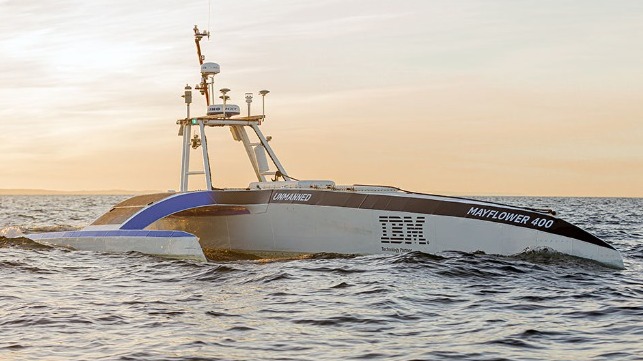Mechanical Problem Stops Mayflower Autonomous Research Vessel

Three days into its historic voyage attempting to become the largest autonomous vessel to cross the Atlantic, project organizers are reporting that the Mayflower has experienced a “small mechanical issue,” and that they are stopping the voyage. A recovery team reached the autonomous vessel on June 21.
“We decided not to force the ship to continue as what's broken is easy to fix at the moment. Our team is on their way to get the ship, and the Mayflower is waiting,” the team put out as a mission status update. Initial updates on June 18 only said that there was a small malfunction, but the vessel would be taken back to base to investigate and that they hoped to restart the voyage shortly.
Images were posted of the recovery vessel arriving at the Mayflower while updates reported that there was still power onboard. However, the teams later reported that while the communications remained live, they had decided to turn off some non-essential systems to conserve power. While few details were offered on their plans, comments talked of getting the vessel back and completing repairs.
Our planned recovery vessel has arrived and after a few checks we’ll head back to base. I’m safe and as you can see, my computer systems are working fine. Thanks to everyone for their support while we figure out this mechanical hitch and get turned around :-) #MAS400 pic.twitter.com/6fpZdj4IP3
— AI Captain - Mayflower Autonomous Ship (@AI_Mayflower) June 21, 2021
After years of research and collaboration between ProMare, a non-profit marine research group, IBM, and partners from industry and academia, the Mayflower had departed on its voyage last week. The goal was to sail the highly sophisticated vessel across the Atlantic on a voyage that was expected to last three weeks before arriving at Provincetown, then make its way to Plymouth, Massachusetts.
During the voyage, the vessel was gathering data about the ocean, designed to help scientists understand key global issues affecting ocean health including ocean acidification, microplastics, and marine mammal conservation. The prototype vessel is part of a program to develop fully autonomous AI systems and applications for use in a variety of industries such as shipping, oil and gas, telecommunications, security and defense, fishing, and aquaculture.
The voyage began at around 4 a.m. local time on June 15 from Plymouth in the U.K. after the team had worked with IBM’s The Weather Company studying weather patterns to identify the best window for the voyage. After two days, the Mayflower had covered more than 250 nautical miles on its 3,800-mile voyage. Observers reported the vessel was averaging just over three knots, and the public was invited to monitor progress and see live data and images in an online dashboard.
